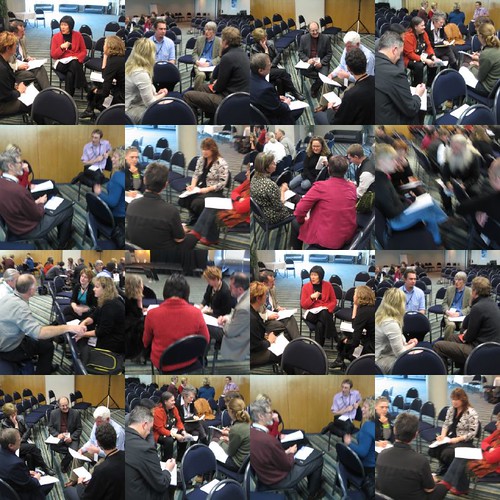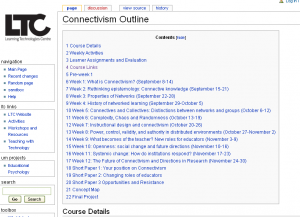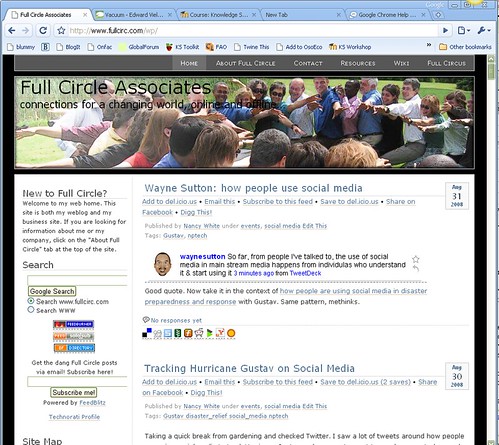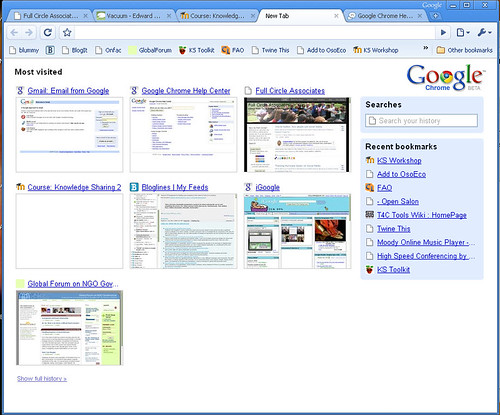Rambly post alert – this one hops all over the place with little regard to coherence.

My friend Mark Hammersley reminded me a few months ago of a tool to help surface intercultural issues and build trust in distributed teams. One was Thiagi’s Multicultural Email Game. (Mark notes it is also included in the “Building Trust in Teams” toolkit, PDF for free or you can buy the book, published by Oxfam www.oxfam.org.uk) I have not used this game and would like to try it – and not just at a F2F meeting, but try it online. It could be tricky because it actually asks participants to trust the process of the game right from the start. But the idea of a game appeals to me, not only for trust building, but as an on-ramp to engagement. Michele Martin shares some of her favorite ice breakers (mostly F2F) which are another way of initiating engagement. Check the comments on the post for more ideas.
So why am I focusing on onramps to engagement today? Two reasons. The first is I’m a guest in a South African workshop on elearning for educators in higher education and almost ALL of their questions have to do with engagement. Most often, “how do I get people to post on discussion boards.” They are also dealing with huge cohorts that blow my mind. How does engagement scale? Wow. I’ll have to save that for another post.
The second reason engagement is top of mind is because I was Skyping with a colleague who is facing challenges getting some organizational partners to participate in a discussion forum. In our conversation we talked about three big barriers. Maybe they will stimulate you to contribute some more issues and ideas.
Why are we talking about discussion forums?
Engagement is an issue with all tools. Tools are the medium to achieve our purpose. It just so happens today people were talking about discussion forums. It is still critical to ask the question “why are we using discussion forums.” Again, I won’t go into that today. So let’s take it as a given just for fun, ok?
Barrier 1: No Shared Context for Learning Together
One of the possible barriers we identified was the different cultural contexts for sharing work in progress as a way of learning. I have found that people often think what they observe and experience won’t have value to others. That their stuff, their “work in progress” is not ‘good enough.’ So one suggestion is to create an example or trial run, and wrap it in an invitation that has relevance and value to the participants. To role model the value of thinking together while working, not just when we are done. This begins to help us see where we have shared and different contexts and how these can add to, not subtract, from our learning.
For example, recruit 2 people from the group – one who is willing to share her workplan (this is what is under discussion) and another to interview the first person with you, the facilitator. Prior to posting, spend some time with person one to see if they need any help preparing the document and give them some feedback about the value of the work. There is always value, trust me. But sometimes we are blind to our own learning and strengths. Then spend some time with the interviewer brainstorming questions. DON’T practice the interview. I find that often saps the life out of things. But prep the initial questions and give tips on how to interview and dig down for the gems rather than just coasting on the surface.
Then create an invitation to the rest of the group to a time delimited interaction. In this example, it is on a discussion forum due to bandwidth limitations. In the invitation, use language that is relevant to the participants interests and needs, such as “come participate in a peer interview with Person 1 and Person 2 where we’ll mine for the gems in a work plan. Get ideas and different perspectives on the work plan process.”
After this interview, do a quick debrief. What did people learn? What did they like about the process? Not like or make them feel uncomfortable. This can surface both focus, technological and cultural issues. Adjust and then encourage others to take a turn their your plans and getting valuable peer feedback.
The debrief, as was cited in the Email Game link above, is the critical part. Without this you have no feedback to adjust and improve. Without the reflection on the process, many of the participants may speed past their own learning and the possibilities of the conversations and learning with others. The “I don’t have time to post on discussion boards.”
Barrier 2: Technology
Wait, I said we were taking forums as a given for this post? Well… maybe not, eh? I work a lot in international contexts where there is little bandwidth equality. Or even electricity parity. Some members are lucky to get online on a patchy dial-up once a week, while others are always on with broadband. A portal or forum tool may just not cut it when it takes 20 minutes to download a page – and worse when that page has no value. Organizations sometimes deny this, but it is real and the sooner we adjust our strategies, the better. So one of the suggestions we talked about on our Skype chat today was the bridging of technologies, specifically text on mobile phones to alert or focus on key web based interactions. It is probably not yet realistic to replace all web interactions – not everyone has web enabled mobiles, but this linkage with the commonly shared tool of mobile phones recognizes the realities of those with less web access and includes them more fully. It is easier to say yes to a text than that 20-minute loading page. So the message to organizations who insist that everything happens on their portal should look again. Rethink the centralized strategy because it is not inclusive in many cases.
Barrier #3: Organizational Foo
Finally, we come to the fun stuff. The elephants in the room. Our own organizational blinders and shortcomings. For example, funders have power over their grantees, so grantees do what they need to to “tick the box” but do they feel ownership of their learning in an experience with a funder, or beholden to the learning agenda of the funder? What real and meaningful roles are available to people? What ownership? Like the tool choices above, the power of the convenor can stifle the engagement of everyone else, especially if their power is disproportionate.
To address these issues, we have to look inward to our organizations and ask the hard questions about our values, how we lead and follow, how we prioritize our time and what we ask of others. If we are asking our colleagues to participate in a web based interaction, we should not dare to refuse to participate ourselves. If we choose technologies that are for our convenience, we should also struggle to master those that are convenient for others. It is a two way street.
Broader issues: Training, Performance Support and Learning
So now, this spreads out to something I’ve been following others on – how we think about learning in the workplace. Is it training? Is it performance support? Is it formal or informal learning? Or better, what should we be pulling out of the bag when? This actually links back to the question, why are we seeking engagement?Yes, for learning, but for what? Why? For whom? Are we being strategic? Are we deluding ourselves that people have time for these distributed, online learning conversations in the first place? Purpose is always first and foremost, but we still slide by it with vague answers. Or we forge ahead with training, performance support or communities of learning and practice without asking about purpose.
If our purpose is clear, then what is the relationship and strategy around training, PS and learning? Too many questions and it is time to go make dinner. How was that for an easy out? 😉
Other people blogging/thinking out loud about this:
Edited to correct some bad spelling boo boos
 I have a tendency to destroy my computer headsets/mics with regularity. I run over the cords, the plugs loosen and then the sound degrades. It is time again to buy a new set, but instead of buying the cheapest set at the local office store, I decided to get the recommendations of my network – since many are also frequent users of this product.
I have a tendency to destroy my computer headsets/mics with regularity. I run over the cords, the plugs loosen and then the sound degrades. It is time again to buy a new set, but instead of buying the cheapest set at the local office store, I decided to get the recommendations of my network – since many are also frequent users of this product.


